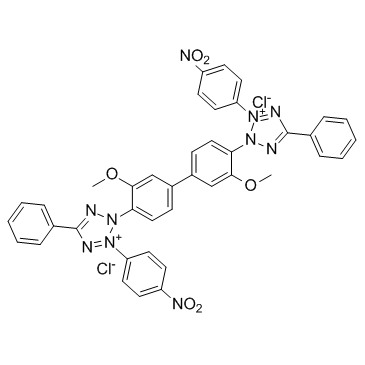NBT

NBT structure
|
Common Name | NBT | ||
|---|---|---|---|---|
| CAS Number | 298-83-9 | Molecular Weight | 817.636 | |
| Density | 1.5521 (rough estimate) | Boiling Point | N/A | |
| Molecular Formula | C40H30Cl2N10O6 | Melting Point | 200ºC | |
| MSDS | Chinese USA | Flash Point | N/A | |
| Symbol |

GHS07 |
Signal Word | Warning | |
|
Proper migration and axon outgrowth of zebrafish cranial motoneuron subpopulations require the cell adhesion molecule MDGA2A.
Biol. Open 4(2) , 146-54, (2015) The formation of functional neuronal circuits relies on accurate migration and proper axonal outgrowth of neuronal precursors. On the route to their targets migrating cells and growing axons depend on both, directional information from neurotropic cues and ad... |
|
|
Local synthesis of interferon-alpha in lupus nephritis is associated with type I interferons signature and LMP7 induction in renal tubular epithelial cells.
Arthritis. Res. Ther. 17 , 72, (2015) Type I interferons are pivotal in the activation of autoimmune response in systemic lupus erythematous. However, the pathogenic role of interferon-alpha in patients affected by lupus nephritis remains uncertain. The aim of our study was to investigate the pre... |
|
|
AMBRA1 links autophagy to cell proliferation and tumorigenesis by promoting c-Myc dephosphorylation and degradation.
Nat. Cell Biol. 17(1) , 20-30, (2014) Inhibition of a main regulator of cell metabolism, the protein kinase mTOR, induces autophagy and inhibits cell proliferation. However, the molecular pathways involved in the cross-talk between these two mTOR-dependent cell processes are largely unknown. Here... |
|
|
Verification of a canine PSMA (FolH1) antibody.
Anticancer Res. 35(1) , 145-8, (2014) Canine prostate cancer (PC) is a highly aggressive malignancy. However, in contrast to man, neither standard screening strategies nor curative therapeutic options exist for the companion animal. A prostate-specific membrane antigen (PSMA) screening as molecul... |
|
|
Evidence for a role of the polysaccharide capsule transport proteins in pertussis pathogenesis.
PLoS ONE 9(12) , e115243, (2014) Polysaccharide (PS) capsules are important virulence determinants for many bacterial pathogens. Bordetella pertussis, the agent of whooping cough, produces a surface associated microcapsule but its role in pertussis pathogenesis remained unknown. Here we show... |
|
|
Postmitotic control of sensory area specification during neocortical development.
Nat. Commun. 5 , 5632, (2014) The mammalian neocortex is subdivided into cytoarchitectural areas with distinct connectivity, gene expression and neural functions. Areal identity is initially specified by rostrocaudal and mediolateral gene expression gradients in neuroepithelial and radial... |
|
|
Protective role of adenylate cyclase in the context of a live pertussis vaccine candidate.
Microbes Infect. 16(1) , 51-60, (2014) Despite high vaccination coverage, pertussis remains an important respiratory infectious disease and the least-controlled vaccine-preventable infectious disease in children. Natural infection with Bordetella pertussis is known to induce strong and long-lastin... |
|
|
Francisella tularensis LVS surface and membrane proteins as targets of effective post-exposure immunization for tularemia.
J. Proteome Res. 14(2) , 664-75, (2015) Francisella tularensis causes disease (tularemia) in a large number of mammals, including man. We previously demonstrated enhanced efficacy of conventional antibiotic therapy for tularemia by postexposure passive transfer of immune sera developed against a F.... |
|
|
Development and in-house validation of an allergen-specific ELISA for quantification of Bet v 4 in diagnostic and therapeutic birch allergen products.
Anal. Bioanal. Chem 407(6) , 1673-83, (2015) Birch (Betula) pollen is a major cause of allergy in northern and central Europe. The allergenic potency of products for diagnosis and therapy of birch pollen allergy is adjusted nearly exclusively to the major birch pollen allergen Bet v 1. Although every fi... |
|
|
Denervation impairs regeneration of amputated zebrafish fins.
BMC Dev. Biol. 14(1) , 49, (2015) Zebrafish are able to regenerate many of its tissues and organs after damage. In amphibians this process is regulated by nerve fibres present at the site of injury, which have been proposed to release factors into the amputated limbs/fins, promoting and susta... |